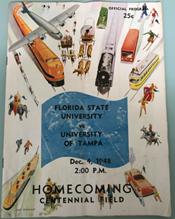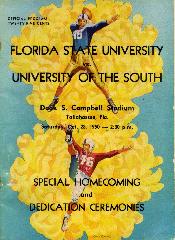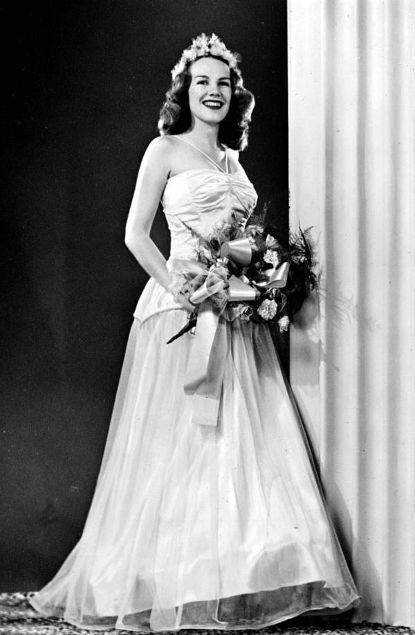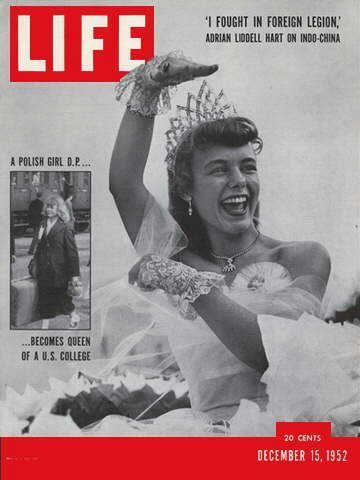The Early Homecoming Celebrations
By Jim Joanos
Homecoming celebrations at Florida State University are special events. In the second season (1948) after the institution changed from a women’s college to an coeducational one, the Seminoles defeated the University of Tampa at Centennial Field in Tallahassee, 33-12, on December 4, 1948. On that weekend, FSU celebrated its first homecoming weekend.
It has been my good fortune to have attended FSU’s homecomings from 1948 through 1956 and from 1962 through 2021. Probably, the most special of all of the homecomings that I have attended was the weekend of October 28, 1950, when FSU defeated Sewanee 27-7. At that game, the new stadium was dedicated and named the Doak S. Campbell Stadium, the Fight Song was sung at a game for the first time and the band adopted the name, “Marching Chiefs.” My memories about the early homecomings are predominately about the ones that I attended as a student (1952-55) and write about in this article.
There were not many male alumni so nearly all the alums that attended were FSCW graduates. Many brought with them their spouses who had attended the University of Florida or other male colleges. The student population was much smaller but bolstered by male students from the other institutions with much smaller female populations who came to Tallahassee for the weekend where the women outnumbered the men by a large margin. There was strong support from the Tallahassee community especially from the banks and businesses. A number of the events were sponsored by business enterprises. It was mainly a local Tallahassee based ceremony quite different than the national gathering that descends upon Tallahassee these days.
On campus, there was very serious competition among the fraternities, sororities, and dormitories regarding house decorations, parade floats, and skits, The themes of which seem to been mostly centered around pride of the organization involved or how badly FSU was going to beat the opposing school. Full nights were spent on perfecting the artwork. Fraternity pledges were especially expected to participate in these projects. Of utmost importance to students was getting a date for the homecoming events. Female students decided to either borrow or buy outfits to wear. Males tried to save a few dollars that would be needed and made arrangements to double date with someone who had access to an automobile.
In the beginning Friday would come and the first thing on the homecoming agenda would be the parade. It would begin downtown and wind its way to the FSU campus, much smaller than today and end somewhere past the Westcott Building where the gate was too small to allow the vehicles access to the center of the campus. There was no horse and rider to lead the parade but there was a pair of male twirlers named, “the flying Seminoles.” It was a pair of guys who combined some acrobatic moves with twirling and leading the band. The pair had been recruited out of a Miami high school and were on scholarships at FSU. The floats decorated by students would be on display and evaluated. University officials as well as the five finalists for homecoming queen would ride in convertibles. Units of FSU’s ROTC units would march. Sometimes the parade would include active-duty soldiers, jeeps, and passenger trucks. Several high school bands from nearby would also be included.
Closely following the parade would be the Homecoming Banquet in the Suwanee Dining Room. Most of the parade participants would go directly to the banquet where they would be joined by additional faculty, administrators, students, and alumni. During the banquet, the finalists for homecoming queen would be introduced. They would be wearing full feathered headdresses similar to those worn by western plains Indians. At the time FSU knew very little about the attire and customs of the Seminole Tribe which did not become a federal recognized tribe until 1957. In later years the “Queen” has been changed to “Princess” and a male “Chief” added. A Seminole turban is now presented to the Chief and beaded head attire for the Princess instead of the incorrect feathered headdresses. Several awards would be presented. The main feature of the program was the speaker who was either a national or even international figure of importance.
Following the banquet came the “Pow Wow.” The Pow Wow of the early years was quite different than the more current ones. They were in Campbell Stadium. They were designed to entertain not just the students and alumni but Tallahassee families and other families in town for the festivities. A main feature was the presentation of the five or so finalists in the skit competition and the award to the best. The winners of the House Decoration competition would also be announced.
FSU’s first homecoming Queen was Clara Moffitt Howell McKay.
Following the homecoming of 1952 something very special occurred. The homecoming queen that year was a very attractive freshman, Marlies Gessler. Marlies, was Polish and as a child was in her home country during World War II when it was occupied by the German army. Several years after that war, as a refugee she and her mother were able to migrate to the USA where they found their way to Tallahassee and she became an FSU student in 1952. As a freshman, she was selected by the FSU student body as homecoming queen. Life magazine thought enough of the story to select her for the cover picture and a story that appeared in the December 15, 1952, issue of that publication.
The early homecoming Pow Wows would also include other forms of entertainment. I remember as if it was yesterday when a student, Delano Driver, in the mid-fifties sang the “Indian Love Call.” Outdoors, in that stadium with not even a whisper from the crowd her voice resonated and echoed to perfection. Most unusual by today’s customs, the FSU football team participated in the Pow Wow. Head Coach Tom Nugent, in order to raise enough money for his college education had been a professional night club singer. He loved to sing. At one Pow Wow Nugent marched the full team up to the stage where they sang the FSU fight song.
While the Pow Wows were going on, a group of Tallahassee store owners and business men began to gather to cook barbecue for the next day’s brunch. I never learned what went on out there but do remember that my Dad dodged any questions about it but couldn’t hide a smile that would cross his face. He was a regular each year. Mid-morning on Saturday, a barbecue fundraiser was held near where Tull Gym is today. Students and alumni attended. Since it was prior to the game, the folks that attended were dressed in their finery. Men wore coats and ties and women had special dresses as well as hats and gloves. Most of the women would have a garnet or gold corsage which their date had given them.
The game would be next. There was no need to hurry as there was available parking right next to the stadium. The game itself was usually the last game of the season except when FSU was invited to one of the hand full of bowl games.
On Saturday night, following the game, students went back to their dorms and got dressed up for the evening’s homecoming Ball at the Suwanee Room. It was time for the student women to put on their long, formal, glittered evening dresses. The male students would get out their white dinner jackets that they had not worn in a while. Music at the Ball was usually supplied by one of the “Big Bands.”
On Sunday mornings, the students tended to sleep late. Some alums would get up and leave so as to get back to their homes at a reasonable time. Some of the alums would attend a morning service at the campus chapels where they had worshipped as students. Most would carry with them a feeling of satisfaction at having attended FSU’s homecoming. That part has not changed.
About the author:
 |
Jim Joanos |
Memories of Garnet and Gold
Jim Joanos and his wife Betty Lou have deep roots at Florida State University. Avid sports fans, they have literally seen, and done, it all. Fortunately for us, Jim loves telling first-hand accounts dating back to FSU’s first football game, a 1947 clash with the Stetson Hatters on Centennial Field, where Cascades Park is today.
The Osceola will run a series of these colorful stories written by the former Tallahassee lawyer and judge, which we feel our readers will find enlightening and/or nostalgic.
Jim and Betty Lou, who was Associate Director of the FSU Alumni Association (1991-2003), have been married 66 years and are each listed as one of FSU’s 100 Distinguished Graduates. The couple were enshrined in the FSU Hall of Fame in 2015 as Moore-Stone Award Recipients. Ironically, both Deans Moore and Stone were instrumental in the Joanoses career development.
“Both Jim and Betty Lou Joanos have been exemplary fans and supporters of Florida State University, both academically and athletically,” said Andy Miller, retired President and CEO of Seminole Boosters, Inc. “You can’t go to an athletic event of any kind that you don’t see both Jim and Betty Lou Joanos together. They love their university as much as they love each other.”



